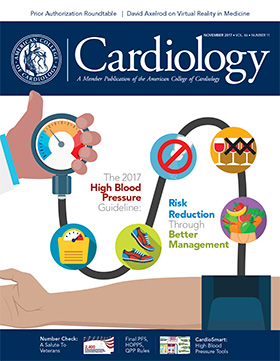At one year, BVS was non-inferior to EES. At three years, the primary endpoint of TLF had occurred in 13.4 percent and 10.4 percent of BVS and EES patients, respectively (p = 0.06). Target vessel failure (TVF) and the composite of all death, all myocardial infarction (MI) or all revascularization through three years occurred more frequently with BVS than EES. BVS vs. EES implantation was an independent predictor of TLF and device thrombosis through three years.
ABSORB IV was conducted in an expanded patient population in which small vessels were avoided and aggressive pre-dilatation and routine high-pressured post-dilatation were encouraged. Patients were randomized to BVS or EES (1,300 per arm). The primary endpoints were TLF at 30 days (non-inferiority) and TLF between three and seven to 10 years (pooled with ABSORB III).
At 30 days, TLF occurred in 5.0 percent and 3.7 percent of BVS and EES patients, respectively (p = 0.11). In BVS patients vs. EES patients, the rate of TVF was 5.1 percent and 3.7 percent (p = 0.07); composite of death, MI and revascularization was 5.2 and 4.1 percent (p = 0.17); and device thrombosis was 0.6 percent and 0.2 percent (p = 0.06).
The FDA continues to recommend that health care providers: Follow the instructions for target heart vessel selection (e.g., avoid BVS use in small heart vessels) and optimal device implantation per BVS physician labeling; Advise patients experiencing new cardiac symptoms such as irregular heartbeats, chest pain or shortness of breath to seek clinical care; Advise BVS patients to follow recommendations for dual antiplatelet therapy as prescribed; Report adverse events related to BVS through MedWatch.
<<< Return to top


 The U.S. Food and Drug Administration (FDA) issued an updated letter informing health care providers of increased rates of major adverse cardiac events in patients receiving the Absorb GT1 bioresorbable vascular scaffold (BVS) based on latest findings from the ABSORB III three-year and ABSORB IV 30-day analyses, presented at TCT 2017. Study results showed BVS was associated with significantly more target lesion failure (TLF) and other adverse events when compared with the everolimus-eluting stent (EES).
The U.S. Food and Drug Administration (FDA) issued an updated letter informing health care providers of increased rates of major adverse cardiac events in patients receiving the Absorb GT1 bioresorbable vascular scaffold (BVS) based on latest findings from the ABSORB III three-year and ABSORB IV 30-day analyses, presented at TCT 2017. Study results showed BVS was associated with significantly more target lesion failure (TLF) and other adverse events when compared with the everolimus-eluting stent (EES).
